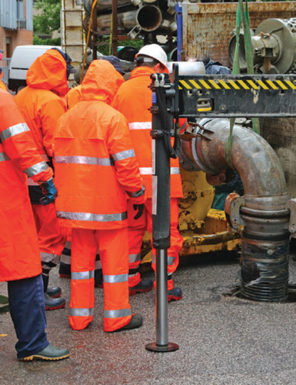Flame-resistant requirements for high-visibility apparel
Why does the high-visibility standard have FR requirements?

Responding is Brian Nutt, product director for protective clothing, Tingley Rubber Corp., Piscataway, NJ.
ANSI/ISEA 107-2010 is the American National Standard for High-Visibility Safety Apparel and Headwear. 2010 is the current revision but an updated version, ANSI/ISEA 107-2015, is due to be published in 2016. An area of the standard that remains is the flame-resistance portion. This doesn’t mean that all high-visibility safety apparel must be FR, but it does mean that if HVSA is marketed as compliant with ANSI 107, the garment must meet specific FR standards in order to claim flame resistance on the ANSI 107 label.
The reason for the inclusion of the FR portion is to overcome the confusion in the marketplace regarding what is and isn’t FR. The concern originated with vests marketed as “FR” that are made of polyester and treated with a flame inhibitor. Although these vests are often tested to ASTM D6413, a vertical flame test, and have a flame out less than or equal to two seconds and a char length less than 6 inches after removal of the ignition source, they are not close to the equivalent performance of products that are considered FR clothing.
End users wearing FR clothing were putting on these FR vests and believing they were protected, when in reality if they were exposed to either an electric arc or flash fire, the vest they were wearing would become a safety hazard. Although appropriate for applications like welding, a treated polyester vest will become molten, melt and drip onto the wearer in an electric arc or flash fire situation.
For that reason, and at the request of many end users, FR standards were included in the ANSI 107-2010 standard. If compliant HVSA is to be marketed as FR, it must be compliant with one of the following standards specifically referenced in the ANSI 107 standard: ASTM F1506, NFPA 70E, NFPA 2112, ASTM F1891, ASTM F2733, ASTM F2302, NFPA 1971 and NFPA 1977.
Compliance includes all labeling requirements associated with the other standards, so an FR, high-visibility garment would have the appropriate FR label information as well as an ANSI 107 label that states it is ANSI 107 compliant for high-visibility and FR. Because this did not completely overcome the confusion in the marketplace, the new 2015 revision goes into even more specificity regarding the required labeling for an ANSI 107 FR garment.
The new revision requires all HVSA to be labeled as either “FR” or “Not FR” next to the pictogram of the garment. The label must also include a statement that the garment is not flame-resistant as defined by ANSI/ISEA 107-2015, or that it is flame-resistant and the standard it meets. (A separate label for NFPA 1977 and NFPA 2112 is required.) NFPA 1971 is no longer included.
Additional information and copies of the ANSI 107 standard can be found at www.safetyequipment.org.
Post a comment to this article
Safety+Health welcomes comments that promote respectful dialogue. Please stay on topic. Comments that contain personal attacks, profanity or abusive language – or those aggressively promoting products or services – will be removed. We reserve the right to determine which comments violate our comment policy. (Anonymous comments are welcome; merely skip the “name” field in the comment box. An email address is required but will not be included with your comment.)

